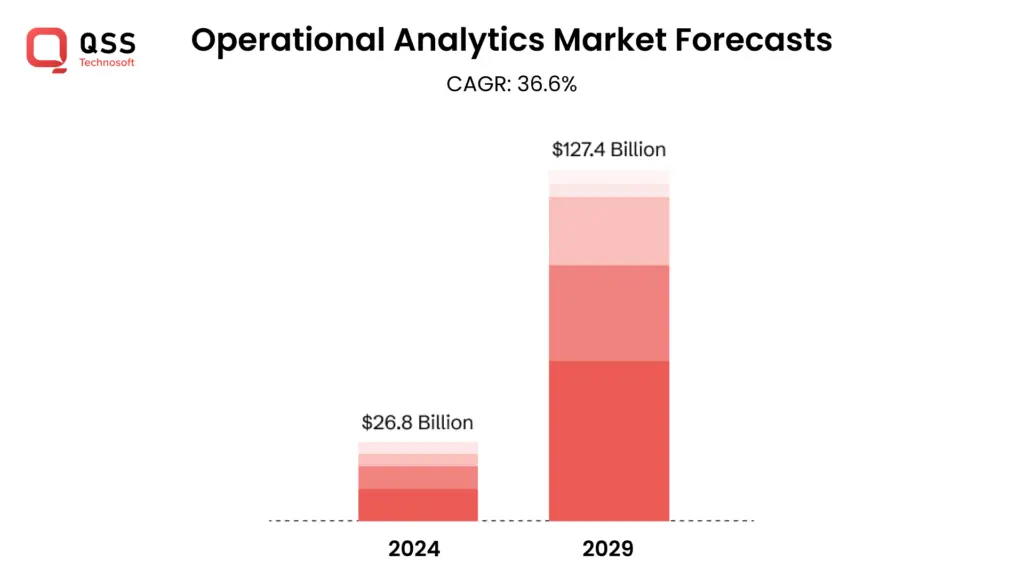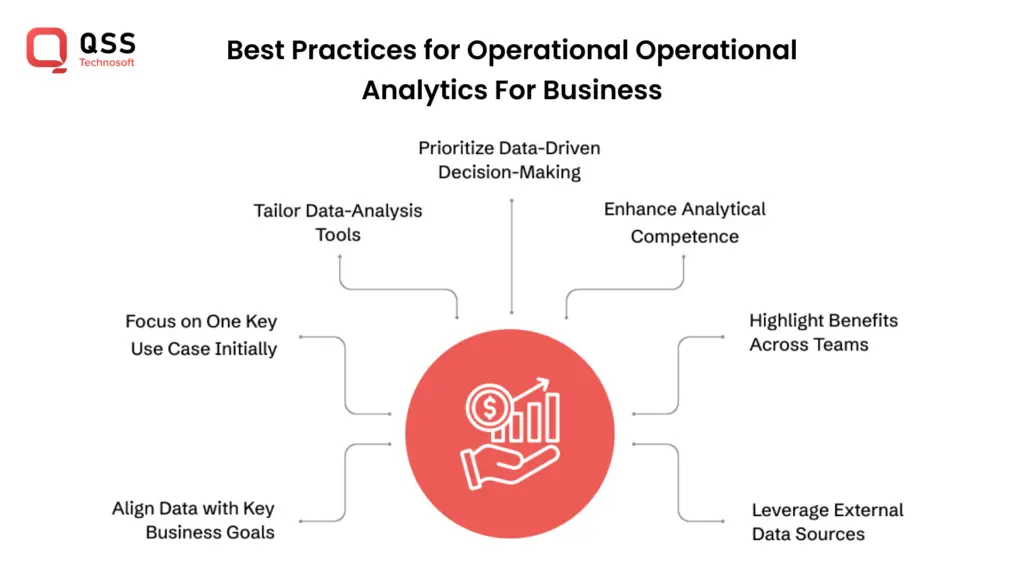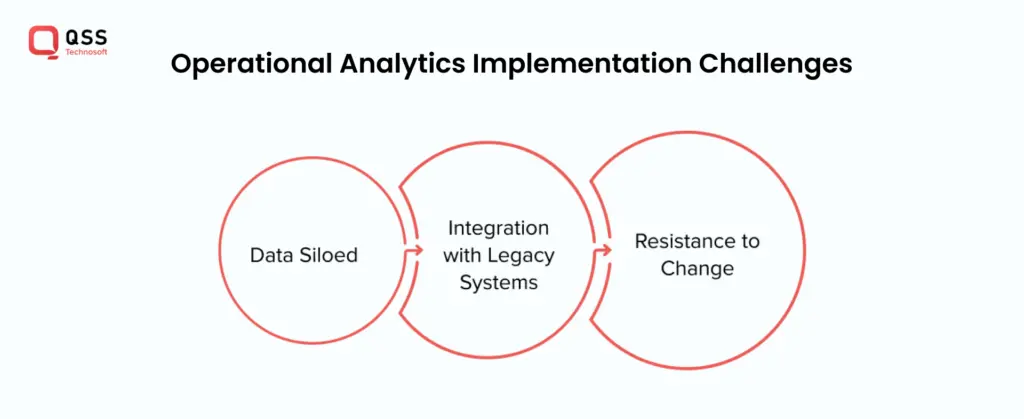In contrast to conventional Business Intelligence (BI), which mostly relies on historical data to provide insights and reports, OA focuses on real-time data collection, analysis, and delivering actionable insights. This allows companies to improve daily operations, swiftly respond to market changes, and increase efficiency.
The significance of OA is evident in the rapid-paced business world which is continuously looking for ways to improve the quality of their decision-making and gain an edge. According to a recent survey conducted by Forrester, 58% of organizations using real-time operational analytics has reported improved decision-making capabilities across all levels of their organizations, showing the power of operational analytics. As businesses are becoming more driven by data, OA has emerged as the primary driver to improve business efficiency, agility, and customer satisfaction.

Also Read:- Optimizing Fintech: How Stripe Harnessed AWS to Scale Secure Payment Processing
Key Use Cases of Operational Analytics Across Industries
Operational Analytics is a tool that can be utilized across a variety of industries, providing businesses with real-time insights that improve the performance of their business. Below are a few most significant use cases of analytical operation:
Retail
Retailers rely on OA to predict demand as well as inventory management and to create a personalized shopping experience for their customers. Real-time information allows businesses to anticipate the needs of customers and adjust their stock levels, accordingly, making sure that the correct items are in stock at the most appropriate moment.
Manufacturing
Predictive maintenance is among the most effective applications in manufacturing. OA helps manufacturers monitor equipment in real-time, predict the likelihood of failures before their occurrence, and plan maintenance to limit downtime, decreasing costs and increasing productivity.
Supply Chain Management
OA assists companies in streamlining the management of their inventory and improving delivery. By analyzing real-time data from warehouses, suppliers as well as delivery vehicles, companies can cut down on shipping delays and increase efficiency of the supply chain.
Banks
Banking institutions employ OA to detect fraud by studying patterns of transactions and flagging suspicious transactions in real time. In addition, OA can provide personalized product recommendations based on customer behavior, improving the experience of customers.
Healthcare
Hospitals and Healthcare providers use OA to improve the quality of care for patients by analyzing patient information in real-time, increasing the accuracy of diagnostic tests, and optimizing the distribution of resources such as staff, equipment, and beds.
Marketing
Marketing teams utilize OA to enhance campaigns by monitoring real-time engagement, making adjustments to the amount of advertising spent, and enhancing customer segmentation using data-driven insights. This results in more targeted advertising and a higher return on investment for marketing campaigns.
Best Practices for Operational Analytics Implementation
The implementation of OA requires a thoughtful approach to ensure that the data-driven insights coincide with the company’s goals. Here are some of the best methods for successful OA implementation:

Align Business Goals with Analytics Objectives
Be sure that your analyses and data collection efforts are in alignment with your company’s overall operational KPIs. This ensures that the data that is derived from OA will result in tangible business benefits.
Real-Time Data Utilization
Businesses like Amazon and Shell have achieved success with real-time analytics to swiftly respond to operational problems. Businesses must use real-time data streams to identify and react to any inefficiencies, anomalies, or opportunities that arise.
Integration of AI and Machine Learning
AI and machine learning models could enhance predictive capabilities, allowing businesses to make more informed choices. For instance, machine learning models could aid in predicting failures of equipment or identify the presence of anomalies that occur in the supply chain.
Data Integrity and Governance
The ability to ensure accurate, clean as well as reliable information is essential for OA success. Companies must develop strong policies for data governance to control data quality, ensure the consistency of data, and also address gaps in the data.
Training Teams for Analytical Success
The employees must be provided with the skills needed to be able to use OA platforms. Regular education and training should be given to team members in the operational department, to ensure they can comprehend the data and make decisions that are based on analytical operation.
Key Implementation Strategies
Effectively implementing operational analytics requires selecting the best methods and tools. Here are some of the most effective methods that can help you gain the most from the power of operational analytics:
Selecting the Best Tools
Picking the appropriate OA platform is crucial. Tools such as Microsoft Power BI, Tableau, or custom-built solutions can offer a variety of capabilities, and their selection is based on the business’s particular needs and budget.
Pilot Testing and Scaling
Start small-scale pilots to collect feedback and then refine the system before spreading it across the entire enterprise. This will allow for the identification of issues and a way to improve the system before full-scale implementation.
Integration with Existing Systems
Integrating OA seamlessly with existing systems such as ERP CRM, and the tools for managing supply chains will provide unification of data and provides a comprehensive perspective of the operations.
Cross-departmental Collaboration
Facilitate collaboration between data science and operational teams to prevent data silos. Collaboration across functions ensures that information is effectively shared between departments, resulting in more effective insights and better decision-making.
Monitor and Refine Regularly
OA is not a one-time event. Monitor performance metrics continuously as well as gather feedback and make changes to improve the system to ensure it is aligned with the business objectives.
Challenges and How to Overcome Them?
While operational analytics can provide important value, there are some challenges organizations face when implementing:

Data Silos
Numerous companies struggle with siloed data that is spread across multiple departments. To break down silos, it requires cross-department collaboration as well as unification of data platforms that can provide extensive insight.
Data Privacy
With the introduction of laws like GDPR and CCPA companies are required to adopt strict data privacy and security measures. Securing compliance and safe data handling practices is vital to ensuring the trust of customers.
Scalability issues
As businesses expand, they require OA solutions to be able to grow with them. To tackle the scalability issues companies should consider investing in cloud-based scalable OA platforms that will expand with their business.
User Resistance
Change management is vital when it comes to introducing new technologies. Educating operational teams, demonstrating the value of OA, and providing continuous support are key strategies for overcoming user resistance.
Also Read:- Blockchain and AI: Innovative Ways They Can Work Together Shape
Conclusion: The Future of Operational Analytics
As operational analytics evolves with the promise of more advanced capabilities driven through AI, IoT, and machine learning. Incorporating IoT devices will facilitate greater data collection in real-time and AI will improve predictive capabilities. Furthermore, the rise of digital twins as well as advanced analytics will give businesses an unprecedented view of their business operations.
Companies that adopt OA will not just improve the current process, but they will also be agile and competitive in an ever-changing environment. By harnessing the power of OA, businesses will be able to drive continual improvement, provide better service to their customers, and attain long-term success.
We are proud to mention that our work has been recognized by leading B2B reviews and research platforms like GoodFirms, Clutch, MirrorView, and many more.

Unlocking the Power of Operational Analytics- Use cases, Best Practices, and Key Implementation Strategies